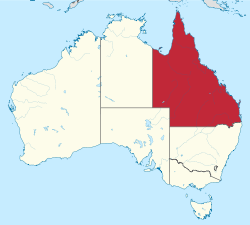Tookoonooka crater

Tookoonooka is a large meteorite impact crater (astrobleme) situated in South West Queensland, Australia. It lies deeply buried within Mesozoic sedimentary rocks of the Eromanga Basin and is not visible at the surface.[1]
Details
Tookoonooka was discovered using seismic data collected during routine petroleum exploration and first reported in a publication in 1989,[2] with proof of the impact theory coming from the discovery of shocked quartz in drill core.[3] Estimates of the crater diameter range from 55 km (34 mi) to 66 km (41 mi).[2][3] The impact occurred during deposition of the Cretaceous Cadna-owie Formation, the age of which is variously estimated at being between 123–133 Ma,[2][3] or 115–112 Ma.[4] Tookoonooka is associated with several small oil fields.[4]
Talundilly crater
The seismic data reveal a similar nearby structure of the same age referred to as Talundilly.[3][4][5] Although it seems likely that Tookoonooka and Talundilly are paired impact craters, proof that the latter is of impact origin is not possible without drilling. Another proposed paired impact craters are the larger West and East Warburton Basin structures in the nearby state of South Australia.[6]
See also
References
- ↑ "Tookoonooka". Earth Impact Database. University of New Brunswick. Retrieved 2007-03-31.
- 1 2 3 Gorter J.D., Gostin V.A. & Plummer P. 1989. The Tookoonooka Structure: an enigmatic sub-surface feature in the Eromanga Basin, its impact origin and implications for petroleum exploration. In: O’Neil B.J. (editor) The Cooper and Eromanga Basins, Australia: Proceedings of the Cooper and Eromanga Basins Conference, Adelaide, 1989, pp. 441–456. Petroleum Exploration Society of Australia, Society of Petroleum Engineers, Australian Society of Exploration Geophysicists (SA Branches).
- 1 2 3 4 Gostin V.A. & Therriault A.M. 1997. Tookoonooka, a large buried Early Cretaceous impact structure in the Eromanga Basin of southwestern Queensland, Australia. Meteoritics and Planetary Science 32, 593–599. Abstract and full PDF
- 1 2 3 Gorter J.D. 1998. The petroleum potential of Australian Phanerozoic impact structures. APPEA Journal 38, 159–187.
- ↑ Longley I.M. 1989. The Talundilly anomaly and its implications for hydrocarbon exploration of Eromanga astroblemes. In: O’Neil B.J. (editor) The Cooper and Eromanga Basins, Australia: Proceedings of the Cooper and Eromanga Basins Conference, Adelaide, 1989, pp. 473–490. Petroleum Exploration Society of Australia, Society of Petroleum Engineers, Australian Society of Exploration Geophysicists (SA Branches)
- ↑ World's largest asteroid impact zone found in Australia: Meteorite broke in two, leaving two craters each 200 km across. Mar 24, 2015
Coordinates: 27°7′S 142°50′E / 27.117°S 142.833°E

